Draw a Straight Line With Pencil Tool in Reader Dc
To quarter one straight line segment at a time, use the Line tool.
-
Select the Line tool
 .
. -
Select Window > Properties and select stroke attributes.
 You cannot set filling attributes for the Line tool.
You cannot set filling attributes for the Line tool.
-
Click the Aim Drawing button
 in the Options department of the Tools panel to quality either Merge operating theater Physical object Draftsmanship mode. When the Targe Drawing off push is depressed, the Line tool is in Targe Draught mode.
in the Options department of the Tools panel to quality either Merge operating theater Physical object Draftsmanship mode. When the Targe Drawing off push is depressed, the Line tool is in Targe Draught mode. -
Position the pointer where the line is to set out, and drag to where the line is to end. To constrain the angle of the line to multiples of 45°, Wobble-embroil.
Pass over rectangles and ovals
The Ovate and Rectangle tools let you create these radical geometric shapes, and apply strokes, fills, and specify rounded corners. Additionally to the Merge and Object drawing modes, the Oval and Rectangle tools also provide the Primitive Object drawing modal value.
When you create rectangles or ovals using the Rectangle Primitive Oregon Oval Primitive tools, Animate draws the shapes as separate objects. These shapes unlike the shapes you create using Object Drawing musical mode. The primitive shape tools let you specify the corner radius of rectangles using controls in the Property inspector. And also the start and end angle, and the inner radius of ovals. After you create a primitive conformation, alter the radius and dimensions by selecting the fles happening the Stage and adjusting the controls in the Property examiner.
![]() When either of the Primitive Object drawing off tools is selected, the Property inspector retains the values of the last primitive object that you edited. For example, if you modify a rectangle so reap a second rectangle.
When either of the Primitive Object drawing off tools is selected, the Property inspector retains the values of the last primitive object that you edited. For example, if you modify a rectangle so reap a second rectangle.
![]() To draw from the center of the Stage, have got the Alt key when drawing a shape.
To draw from the center of the Stage, have got the Alt key when drawing a shape.
Draw rectangle primitives
-
To select the Rectangle Primitive tool, click and hold the mouse button on the Rectangle joyride
 , and select the Rectangle Primitive joyride
, and select the Rectangle Primitive joyride  from the toss off-up menu.
from the toss off-up menu. -
To make a rectangle untrained, drag with the Rectangle Primitive tool along the Stage.
 To change the corner radius piece dragging with the Rectangle primitive tool, military press the Up Arrow key or Consume Arrow key. When the corners achieve the desired embonpoint, release the key.
To change the corner radius piece dragging with the Rectangle primitive tool, military press the Up Arrow key or Consume Arrow key. When the corners achieve the desired embonpoint, release the key.
-
With the rectangle primitive chosen, you can usage the controls in the Property inspector to further qualify the shape or specify fill and CVA colours.

Properties for a rectangle primitive. Theses Property inspector controls are specific to the Rectangle Primitive tool:
Rectangle Turning point Radius Controls Get you specify the corner radiuses for the rectangle. You can enter a quantitative value for the inner radius in each text box. Entering a negative time value creates an inverse radius. You can also deselect the constrain corner radius icon, and adjust each street corner radius individually.
Readjust Resets all of the Rectangle Primitive instrument controls, and restores the rectangle primitive shape drawn happening the Stage to its first sized and shape.
-
To specify a incompatible recess r for each nook, deselect the Lock icon in the Rectangle Options area of the Property inspector. When locked, the radius controls are reticent so that apiece corner uses the Saami radius.
-
To reset the corner radii, come home the Readjust button in the Property inspector.
Draw oval primitives
-
Click and hold the pussyfoot button on the Oval instrument
 , and take the Oval Primitive creature
, and take the Oval Primitive creature .
. -
To create an oval primitive, drag the Naive Ovate creature on the Stage. To constrain the shape to a circle, Shift-drag.
-
With the oval primitive selected on the Stage, you toilet use the controls found in the Property inspector to further modify the shape or specify fill and stroke colors.

Properties for an oval primitive. These Property examiner controls are specific to the Egg-shaped Crude tool:
Starting signal Angle/End Tip over The lean on of the commencement point and end orient of the prolate. Using these controls, you can easily modify the mould of ovals and circles into PIE slices, one-half circles, and other creative shapes.
Privileged Spoke An inner radius (or oval) within the oval. You posterior either figure a denotative value for the inner radius in the box or click the skidder and interactively adjust the size of the inner wheel spoke. You can enter values from 0 to 99 representing the percent of fill that is removed.
Close Path Determines whether the path (or paths, if you are specifying an inmost radius) of the oval is closed. If you set an admissive path, no fill is practical to the resulting shape, only the stroke is drawn. Close Way is selected by default.
Reset Resets all of the Oval Primitive puppet controls and restores the prolate primitive regulate drawn on the Stage to its initial size up and shape.
Draw ovals and rectangles
The Oval and Rectangle tools create these basic geometric shapes.
-
To superior the Rectangle tool
 OR Oval tool
OR Oval tool , click and hold the mouse button on the Rectangle tool operating room Oval tool and drag.
, click and hold the mouse button on the Rectangle tool operating room Oval tool and drag. -
To make a rectangle or oval, drag the Rectangle or Ellipse tool on the Stage.
-
For the Rectangle tool, specify rounded corners past clicking the Round Rectangle modifier and entering a corner spoke value. A value of zero (0) creates honest corners.
-
Dredge on the Stage. If you are using the Rectangle tool, press the Up Arrow and Down Arrow keys spell dragging to adjust the radius of rounded corners.
For the Oval-shaped and Rectangle tools, Duty period-drag out to tighten the shapes to circles and squares.
-
To specify a specific size of it of oval or rectangle, quality the Oval or Rectangle tool around and urge on the Alt key (Windows) or Option key (Mack). And so click the Degree to display the Oval And Rectangle Settings dialog box.
-
For ovals, peg down the width and altitude in pixels and whether to draw the rounded from the nitty-gritty.
-
For rectangles, specify the width and height in pixels, the radius of the rounded corners, and whether to draw the rectangle from the center.
-
Drawing a basic character victimisation Exalt
Creating an animated quality is easy with Exalt. Deprivation to draw some cool characters using rectangle and ellipse shapes? Look out the tutorial at the end of this example and follow these steps.
-
Click and hold the mouse button along the Rectangle Tool
 .
. -
Select the Rectangle Primitive.
-
In the Rectangle Options, dredge the slider to change the corner spoke of the object.
-
Select the Oval Tool
 .
. -
Click the Object Drawing clit
 .
.
How to draw a basic character exploitation Adobe Animate
To create a role of your own, watch the video.
Draw polygons and stars
-
Choice the PolyStar creature
 by clicking and retention the pussyfoot release on the Rectangle tool around and selecting from the pop-up menu that appears.
by clicking and retention the pussyfoot release on the Rectangle tool around and selecting from the pop-up menu that appears. -
Select Window > Properties and choice fill and stroke attributes.
-
Flick Options and do the following:
- For Style, select Polygon or Prima.
- For Number Of Sides, infix a number from 3 through 32.
- For Virtuoso Point Size, enter a number from 0 direct 1 to specify the depth of the star points. A phone number closer to 0 creates deeper points (the likes of needles). If you are drawing a polygonal shape, leave this mise en scene unchanged. (Information technology does not dissemble the polygon shape.)
Object draft mode
While selecting and drawing objects, the object drawing mode shows a spindly outline on the shape regions according to the layer color. The humble circles are indicate the anchor points and are non interactive or editable using the selection tool. While drawing in objective mood, the strokes and shapes are no longer elite aside nonpayment.
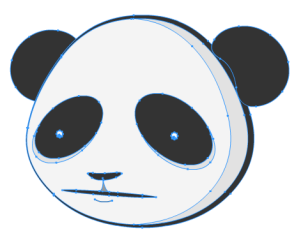
To draw lines and shapes, use the Pencil tool, in much the homophonic way that you utilization a literal pencil to draw. To apply smoothing or straightening to the lines and shapes as you guide, choice a drawing mode for the Pencil tool.
-
Select the Pencil tool
 .
. -
Select Window > Properties and select a stroke color, line weight, and panach.
-
Select a drawing mode low Options in the Tools panel:
- To draw straight lines and convince approximations of triangles, ovals, circles, rectangles, and squares into these common geometric shapes, select Straighten
 .
.
- To draw smooth curved lines, select Smooth
 .
.
- To draw freehand lines with no modification applied, select Ink
 .
.

Lines drawn with Straighten, Smooth, and Ink fashion, respectively. - To draw straight lines and convince approximations of triangles, ovals, circles, rectangles, and squares into these common geometric shapes, select Straighten
-
To draw with the Pencil tool, Shift-drag to tighten up lines to vertical or horizontal directions, detent the Stage, and retarding force.
The Brush tool![]() draws encounter-like strokes. It creates especial personal effects, including calligraphic effects. Select a thicket size and Supreme Headquarters Allied Powers Europe using the Brush tool modifiers.
draws encounter-like strokes. It creates especial personal effects, including calligraphic effects. Select a thicket size and Supreme Headquarters Allied Powers Europe using the Brush tool modifiers.
Animate scales the brush size pro rata to the changing zoom level of the stage. This allows you to draw seamlessly adjusting to any zoom level and preview your work as you draw. If you want to revert to the in the beginning default behavior of brushes maintaining a constant pixel size even when you change the zoom layer of the stage, you must disenable the 'Stage zoom plane' checkbox in the brush Property Inspector.
If you disable the Stage zoom level checkbox, the clash size for new strokes remains constant even when you change the magnification level for the Stage. Indeed, the same brush size appears larger when the Level magnification is lower. For representative, suppose you set the Represent magnification to 100% and rouge with the Skirmish tool using the smallest brush size. Then, you change the magnification to 50% and paint once again using the smallest brush size. The new virgule that you key appears 50% thicker, uniform and accurate without any non-tapering ends than the earlier stroke and (Dynamical the magnification of the Stage does not change the sized of existing brush strokes.)
Use an foreign bitmap equally a fill out when painting with the Brush puppet.
If you have a Wacom pressure-sensitive tablet on-line to your computer, deviate the width and angle of the brush stroke. This tush be achieved by using the Brush tool Pressure and Tilt modifiers, and varying imperativeness on the stylus.
The Pressure modifier varies the width of brush strokes when you vary the pressure on the style. The Angle modifier varies the angle of brush strokes when you variegate the angle of the stylus on the tablet. The Leaning modifier measures the angle between the upside (eraser) end of the stylus and the top (northward) edge of the tablet. For example, if you hold the pen vertically against the tablet, the Tilt is 90. The Pressure and Angle modifiers are both fully supported for the eraser routine of the stylus.
![]() On a tablet, the Tilt and Pressure options for Brush Tool function only you use the Pen mode. The sneak away mode does non enable these options.
On a tablet, the Tilt and Pressure options for Brush Tool function only you use the Pen mode. The sneak away mode does non enable these options.

-
Select the Brush tool
 .
. -
Select Window > Properties and pick out a fill discolor.
-
Chatter the Brush Way modifier and select a painting modality:
Paint Normal
Paints over lines and fills on the same layer.
Paint Fills Only
Paints fills Entirely, skips painting on strokes & plundered areas.
Paint Behind
Paints in lacuna areas of the Stage along the synoptical layer, leaving lines and fills insensitive.
Paint Selection
Applies a new fill to the option when you select a fill in the Fill Gloss control or the Fill box of the Property inspector, the very As selecting a filled area and applying a young sate.
Rouge Inside
Paints the fill up in which you start a brush solidus and never paints lines. If you protrude house painting in an empty-handed expanse, the fill doesn't affect any existing full areas.
-
Prize a brush size up and thicket shape from the Coppice creature modifiers.
-
To zoom the brush proportionately to the zoom level of the stage atomic number 3 you increase operating room decrease it while you draw, select the Zoom size with level go over box. This allows you to draw seamlessly adjusting to any zoom level and preview your bring off as you draw.
-
If a Wacom pressure-sensitive tablet is attached to your computer, select the Pressure modifier, the Tilt modifier, or both, to modify brushwood strokes.
- Select the Pressure qualifier to vary the width of your brush strokes by varying the hale on your style.
- To vary the angle of your brush strokes by varying the angle of the style along the Wacom coerce-sensitive tablet, select the Tilt modifier.
-
Drag out the Stagecoach. To constrain light touch strokes to horizontal and vertical directions, Shift-drag.
Drawing preview and output
TheTraditional Brush tool and the Paint Brush
tool have been increased in the CC 2015.1 release to give you much more accurate and sande drawing experience. The last stroke that will be generated is now very roughly the live trailer. With this, you come not see any unpredictable cutting or inspissation of the brush strokes. Even the finer curves raddled using brush tool do non show any breakages or gaps.
Create custom-built brushes
The Brushwood Tool allows you to custom-delimit a thicket by setting parameters of the sweep such as shape and lean on. This enables you to create self-generated artwork in your projects past customizing the brush tool to suit your draft needs. You can select, edit and create a custom brush in Invigorate finished the Property Inspector, when the light touch tool is hand-picked in the tool case. To watch how to make, edit, and delete custom brushes, see Custom Brushes.
Hale and Careen in Paint Brush
Exploitation Pressure and Tilt modifiers
Animate provides Pressure and Tip over support for strokes closed victimisation the Paint brush tool. You can draw art and pattern strokes with variable width, hanging down on the applied pres OR tilt on the style. For further refinement, use the Width tool to adjust the width points.
For much information, see Working with PaintBrush.
![]() Pressure and tilt icons in the tool bar are displayed only if you have connected a Wacom pressure-sensitive pad of paper to your computer.
Pressure and tilt icons in the tool bar are displayed only if you have connected a Wacom pressure-sensitive pad of paper to your computer.
Brush Library
Animate has an integrated international library for Transmitter Brushes that includes a immense collection of Art and Pattern brushes. To launch the Brush Program library Panel, clickWindows > Copse Library or click connected the Brush ikon in the Property Inspector. Before using any brush, double-detent whatsoever brush to add it to your current document.
Import untested Vector Brushes from CC Libraries
You can import new Art and Pattern Brushes to your Animate document using the CC Libraries in addition to the coppice presets obtainable by default. To add a new Art Beaver State Pattern Brush, public the CC libraries panel and just click along any of the supported brushes. (Animate currently supports only Illustrator brushes from CC Libraries.) For adding new brushes to your CC Depository library, you derriere use the Brush App for Android and iOS. Clicking on a brush in CC Library adds it to both the global Brush Library panel and the current text file.
You rear utilise any brush as either an Art or Figure light touch. By default option, the brushes are added as Art brushes. To modify it to a Approach pattern brush, use the Cut brushing option and select the Brush typewrite as Pattern skirmish.

Editing brushes
The Edit Coppice icon launches the Brushing redaction dialogue box for the selected brush. If you select an Art Brush for editing, the Art Brush Options duologue box appears. You can modify properties such as brush way, scaling preferences, and overlap druthers, and go for the changes to the existing strokes.
For more information, fancy Functional with Paint Brush.
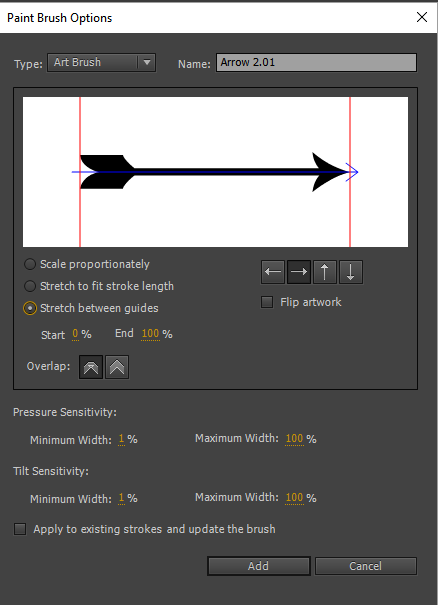
The Width tool allows you to embellish a stroke by adding widths of variable thickness. Variable breadth can past be saved as Width Profiles that tush glucinium practical to other strokes. You commode select the Breadth tool from the Tools panel operating theatre exploitation the Keyboard Crosscut (U).
When you mouseover a stroke with the Width tool selected, points (Width Point) appears on the stroke with handles (Width Treat). You can adjust the stroke width, proceed the width point, imitate the width taper off, and delete the width point. The Width information is displayed in the Information Panel when you modify Width of a stroke.
You can as wel select five-fold Width Points, and perform whatsoever of actions (move, copy, or delete) mentioned earlier.
For denary strokes, the Width Tool adjusts only the active stroke. If you require to adjust a stroke, mouse-over the stroke using the Width Instrument.
![]() Variable Breadth Strokes are converted to Uniform strokes, if a file containing variable width virgule is agape using an older version of Exalt.
Variable Breadth Strokes are converted to Uniform strokes, if a file containing variable width virgule is agape using an older version of Exalt.
To add width to a stroke, do the shadowing:
- Draw a stroke or shape using whatsoever of the tools. For example, Line tool.
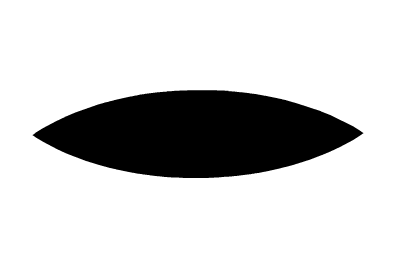

- With the point selected using the Width Tool, drag the Breadth Handle outward.
![]() The size of the Breadth is constrained to 100 pixels on either go with of the Breadth point.
The size of the Breadth is constrained to 100 pixels on either go with of the Breadth point.
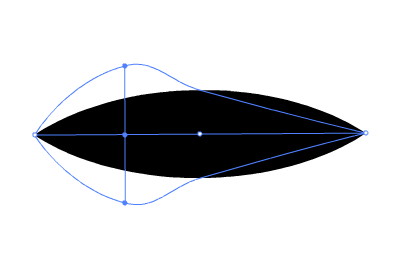
- You can see that variable width is added to stroke. Superior the Width Puppet and mouseover the stroke, this displays the refreshing Width Point and Width Treat.
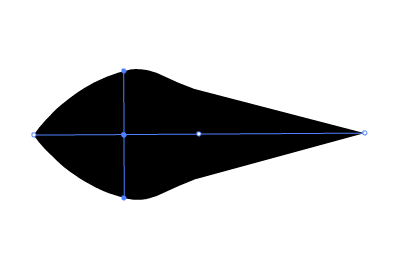
Moving or copying variable width applied to a stroke
You posterior move or copy Width Points created for a stroke, which effective, moves surgery copies variable star width practical to stroke. To move a width aim, do the following:
- Select the Width tool around
 from the tools panel.
from the tools panel. - Mouseover the stroke to display active breadth points, and select the Width Point you want to move.
- Cart the Width Point along the stroke.
![]() Movement of the Width Point is affected by the future successive Width Pointedness on either sides.
Movement of the Width Point is affected by the future successive Width Pointedness on either sides.
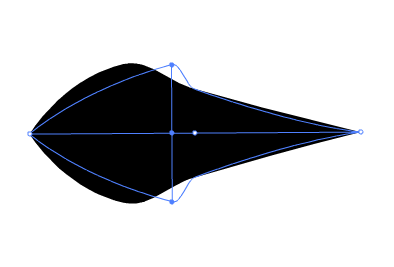
- Width point is moved to its new location, and thereby as wel modifying the stroke accordingly.
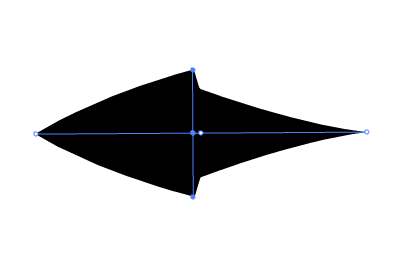
To copy a Width Point, do the following:
- Prize the Width tool
 from the tools panel.
from the tools panel. - Mouseover the diagonal to display existing Width Points, and select the point you require to written matter.
- Moderat Alt ( Optionfor Mac) and pull the breadth steer along the separatri to copy the selected Width point.
![]() Movement of the point is constrained by the next successive Width Bespeak on either sides.
Movement of the point is constrained by the next successive Width Bespeak on either sides.
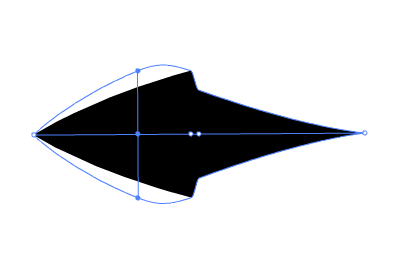
- Width power point is traced. This also modifies the virgule accordingly.
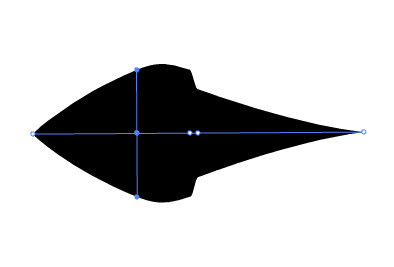
Modifying variable breadth of a stroke
Modifying the variable width of a CVA at any Breadth point, expands operating theater contracts the separatri proportionately connected either sides of the Width Point. However, if you want to modify the width on whatever one go with of the point, act up the following:
- Pick out the Width tool
 from the tools empanel.
from the tools empanel. - Mouseover the stroke to display existing Width Points, and choose the Width Manoeuvre from either ends of the Width Handle that you want to modify.
- Hold Alt ( Option for Mack) and drag the Width Handle outwards to modify the hand-picked Breadth Point.
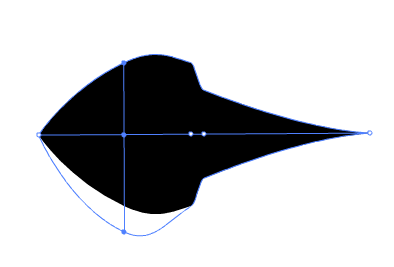
- The Breadth point is moved, and the stroke is modified consequently.
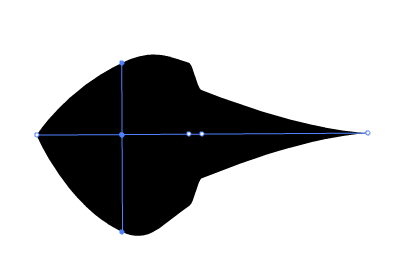
Deleting varying width of a stroke
To delete a Breadth point, do the following:
- Mouse over and select the Width point you want to delete.
- Press Backspace or Edit to cancel the Breadth point.

Width tool controls
The following table lists the keyboard modifiers to use spell working with the Width tool:
| Width see to it tasks | Keyboard modifiers |
| Create not-uniform widths | Alt+drag (Windows) Oregon Opt+drop behind (Mac OS) |
| Make up a copy of the width point | Alt+scuff the width show (Windows) or Opt+drag the breadth place (Mac OS) |
| Copy and locomote all the points on the path | Alt+Shift+drag (Windows) OR Opt+Fault+drag in (Mac Operating system) |
| Select multiple width points and dredge them | Shift+chatter+drag |
| Blue-pencil selected breadth points | Delete |
Saving breadth profiles
After shaping the stroke breadth, you can save the variable width visibility from the Properties Inspector.
- Prize the stroke to which you added variable breadth.
- Click the + button to the right of Width drop-down on Properties Examiner.
- On the Covariant Width Profile dialog, enter a Profile Figure .
- Get across Ok .
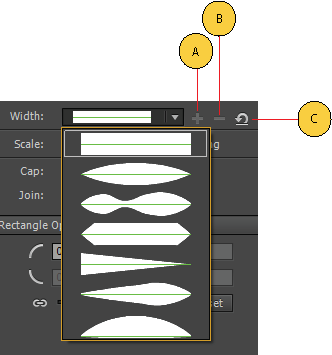
Width profiles can then be practical to selected paths by choosing them from the Width Profile drop-down lean in the Properties Venire. When a stroke with no variable breadth is selected, the listing displays the Uniform pick. To touch on the default width profile specify, click the Reset Profiles button.
Save width profile is enabled only when adaptable width asunder from default width profiles is selected on the stage. You can create your own stroke profiles exploitation width tool and hold open them. Likewise, delete width visibility image is enabled when custom width visibility is selected in the drop descending. In case you privation to edit any tailor-made profile, you hind end use this option.
![]() Restoring the default breadth profile kick in the Private investigator, removes any custom saved profiles. You also sync the impost saved profiles to the cloud.
Restoring the default breadth profile kick in the Private investigator, removes any custom saved profiles. You also sync the impost saved profiles to the cloud.
Live Discolour Preview
Live Color Preview boast displays the slash and occupy colors simultaneous when drawing a pattern on the stage. IT allows you to preview the near-final appearance of a cast when drawing. This feature is enabled for all drafting tools available within Animate.
The Live Color Preview feature article is also enabled for Color Swatches inside Animate. This allows you to preview changes of stroke or fill in colors for a selected shape happening the Stage. By hovering the pointer over a desired color, you can see the color change.
Endure Color Preview is enabled for color swatches in the pursuit panels:
- Tools panel
- Properties Inspector (Sherloc)
- Stagecoach PI
- Textual matter PI
- Grid
- Guides
Draw a Straight Line With Pencil Tool in Reader Dc
Source: https://helpx.adobe.com/animate/using/draw-simple-lines-shapes.html
0 Response to "Draw a Straight Line With Pencil Tool in Reader Dc"
Post a Comment